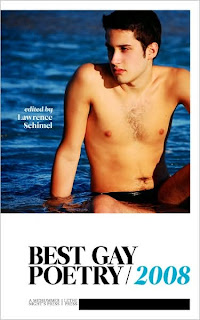Best Gay Poetry 2008

From the press release on Amazon: Best Gay Poetry is a new annual series collecting the best gay poems of the year before. It offers both poetry aficionados and casual gay readers an easy way to keep abreast of the field and find poems that speak to their experience. Editor Lawrence Schimel has brought together a diverse array of poems and voices, not merely in their poetic style and form, but also in how gay subjects and themes are addressed. Drawing on poems published in journals, anthologies, and single-author collections, Best Gay Poetry 2008 offers up the cream of the crop of what was published in 2007, gathered together in one handy volume. Featuring work from 50 gay poets, readers will find herein a mix of established poets and exciting new voices, including Carl Phillips, Rane Arroyo, David Bergman, Timothy Liu, Brad Gooch, Reginald Shepard, Jeff Mann, Steve Fellner, Jee Leong Koh, Steven Cordova, Jericho Brown, and many others. Best Gay Poetry 2008 also includes an annotated...



